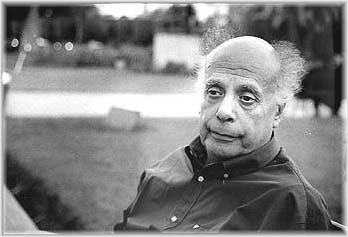
‘Rafi is one of the Pharaonic dynasties. The power and endurance in his materials will long live against time and emptiness.’
Alberto Giacometti
Samir Rafi’s early life consists of a chain of chance encounters that ultimately shape his artist career. Later, when he took matters into his own hands, the trajectory of his life took different forms depending, among other things, on national and regional context, colonial politics, personal ambitions, and commercial interests.
Born in the Sakkakini district in Cairo on 15 August 1926, Samir Rafi was a painter, sculptor, arts educator, and author. An ambitious individualist from the beginning, Rafi was destined to an impressive career in his homeland. A prodigious trendsetter who broke boundaries with visual innovations that linked Egyptian imagery with the human subconscious, he began his career in Egypt in World War II, producing works depicting ordinary daily life far ahead of his time. This explains why the “Cairo Years” between 1942 and 1954 is generally considered the highpoint of his career and cemented Rafi as one of Egypt’s most important revelations when he co-founded what became seen as the most inventive art movement in twentieth-century Egypt.
And yet despite his short productive period in Egypt, Samir Rafi created an Egyptian spirit that surpassed the contingencies of race and geography to reach the human absolute and worked prolifically to create what he dubbed in 1945 ‘an International Egyptian Surrealism movement.’ To do that, he sacrificed his homeland, wife, children, friends, and colleagues and spent the last decades of his life in seclusion in Paris.
Driven by the hope to achieve international recognition, Rafi left Egypt at the peak of his career in June 1954. He remained abroad until he died in 2004, never returning, albeit for one month during the summer of 1964. As he moved to Paris and remained there for 50 years uninterrupted, albeit a five-year stay in Algeria, his work shows signs of melancholy and homesickness, as Rafi repeatedly exploited his style and themes throughout the remainder of his life. Only this time, they became more Egyptian.
Only Sami (1931-2019), his younger brother and the architect behind the Tomb of the Unknown Soldier, remained his lifetime pen friend and confidant.
By his death, Rafi belonged neither in Egypt nor in France. His ability (or rather inability) to overcome obstacles became the subject of his work which explains the more somber, enigmatic, highly sexual, and darker side.
Scattered around the world and divided into two periods: Egypt until 1954 and post-Egypt, his exceptionally prolific production easily exceeds thousands of paintings using different media, (lost) objects and sculptures, drawings, collage, sketchbooks, and tapestries and invites a deeper examination into folk surrealism to seal Rafi into the historical art canon.